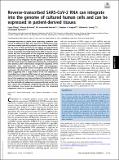| dc.contributor.author | Zhang, Liguo | |
| dc.contributor.author | Richards, Alexsia | |
| dc.contributor.author | Barrasa, M. Inmaculada | |
| dc.contributor.author | Hughes, Stephen H. | |
| dc.contributor.author | Young, Richard A. | |
| dc.contributor.author | Jaenisch, Rudolf | |
| dc.date.accessioned | 2021-05-24T14:06:10Z | |
| dc.date.available | 2021-05-24T14:06:10Z | |
| dc.date.issued | 2021-05 | |
| dc.date.submitted | 2021-03 | |
| dc.identifier.issn | 0027-8424 | |
| dc.identifier.issn | 1091-6490 | |
| dc.identifier.uri | https://hdl.handle.net/1721.1/130644 | |
| dc.description.abstract | Prolonged detection of severe acute respiratory syndrome coronavirus 2 (SARS-CoV-2) RNA and recurrence of PCR-positive tests have been widely reported in patients after recovery from COVID-19, but some of these patients do not appear to shed infectious virus. We investigated the possibility that SARS-CoV-2 RNAs can be reverse-transcribed and integrated into the DNA of human cells in culture and that transcription of the integrated sequences might account for some of the positive PCR tests seen in patients. In support of this hypothesis, we found that DNA copies of SARS-CoV-2 sequences can be integrated into the genome of infected human cells. We found target site duplications flanking the viral sequences and consensus LINE1 endonuclease recognition sequences at the integration sites, consistent with a LINE1 retrotransposon-mediated, target-primed reverse transcription and retroposition mechanism. We also found, in some patient-derived tissues, evidence suggesting that a large fraction of the viral sequences is transcribed from integrated DNA copies of viral sequences, generating viral–host chimeric transcripts. The integration and transcription of viral sequences may thus contribute to the detection of viral RNA by PCR in patients after infection and clinical recovery. Because we have detected only subgenomic sequences derived mainly from the 3′ end of the viral genome integrated into the DNA of the host cell, infectious virus cannot be produced from the integrated subgenomic SARS-CoV-2 sequences. | en_US |
| dc.description.sponsorship | NIH (1U19AI131135-01; 5R01MH104610-21) | en_US |
| dc.language.iso | en | |
| dc.publisher | National Academy of Sciences | en_US |
| dc.relation.isversionof | http://dx.doi.org/10.1073/pnas.2105968118 | en_US |
| dc.rights | Article is made available in accordance with the publisher's policy and may be subject to US copyright law. Please refer to the publisher's site for terms of use. | en_US |
| dc.source | PNAS | en_US |
| dc.title | Reverse-transcribed SARS-CoV-2 RNA can integrate into the genome of cultured human cells and can be expressed in patient-derived tissues | en_US |
| dc.type | Article | en_US |
| dc.identifier.citation | Zhang, Liguo et al. "Reverse-transcribed SARS-CoV-2 RNA can integrate into the genome of cultured human cells and can be expressed in patient-derived tissues." Proceedings of the National Academy of Sciences 118, 21 (May 2021): e2105968118. | en_US |
| dc.contributor.department | Massachusetts Institute of Technology. Department of Biology | en_US |
| dc.relation.journal | Proceedings of the National Academy of Sciences | en_US |
| dc.eprint.version | Final published version | en_US |
| dc.type.uri | http://purl.org/eprint/type/JournalArticle | en_US |
| eprint.status | http://purl.org/eprint/status/PeerReviewed | en_US |
| dc.date.updated | 2021-05-21T11:49:29Z | |
| dspace.orderedauthors | Zhang, L; Richards, A; Barrasa, MI; Hughes, SH; Young, RA; Jaenisch, R | en_US |
| dspace.date.submission | 2021-05-21T11:49:31Z | |
| mit.journal.volume | 118 | en_US |
| mit.journal.issue | 21 | en_US |
| mit.license | PUBLISHER_POLICY | |
| mit.metadata.status | Complete | |
